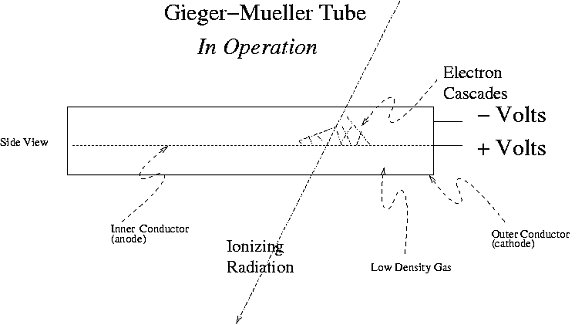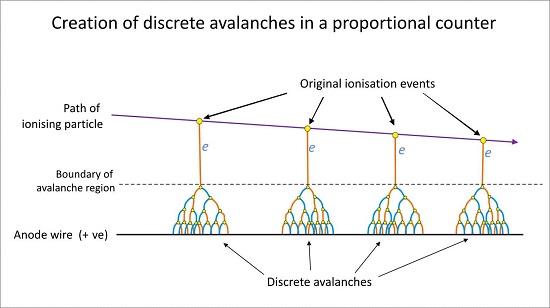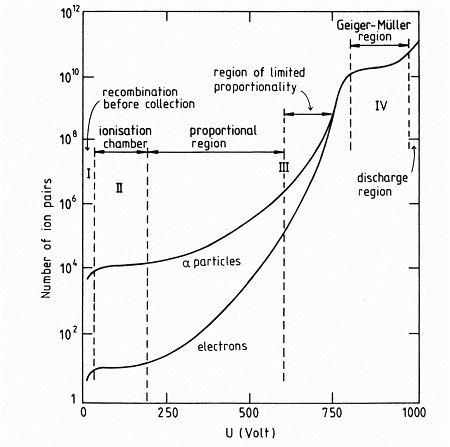Dear Dr. Zoomie – I’ve got all these Geiger counters but I have no idea how they work. Plus, somebody told me that they can only be used for a few types of measurements. Is it true that I can’t use my Geiger counter to measure radiation dose rate? And how DO they work, anyhow?
Geiger counters are part of a family of radiation detectors called “gas-filled detectors.” These detectors – as suggested by the name – are filled with gas. They have an electrode in the middle of the chamber and are set up so that there’s an electrical voltage between the electrode and the metal wall of the chamber – in a Geiger counter, for example, the voltage difference between these is about 900 volts. When radiation hits the molecules of gas in the tube it strips electrons off of the atoms – this process is called ionization. The electron is attracted to the positive charge of the anode and the rest of the atom (a positively charged ion) rushes towards the wall of the tube. Then the electron travels through the wires that make up the electrical circuit and recombines with the ion – part of this electrical circuit is a device that measures the flow of electrons.

Of course, it’s hard to measure a single electron – luckily the instruments don’t have to do so. When the electron and ion are accelerated towards the electrode and chamber walls they gain a LOT of energy because of the high voltage – they bump into other atoms and knock electrons off of them in a process called secondary ionization. Those electrons and ions, in turn, cause even more ionizations and so on – this amplifies the original signal by a huge degree, to a point where it can be measured.

In a Geiger counter, the voltage is so high that the entire chamber of gas becomes ionized – this gives the highest sensitivity to incoming radiation. In other detectors (called ion chambers and proportional counters) the voltage is lower and the amount of gas amplification is lower as well; only some of the gas atoms are ionized in these detectors. The amount of amplification from increasing voltage is shown in the graphic.
To make sense of this graph – especially when it comes to understanding some of the limitations of Geiger counters – it helps to understand that alpha particles have a lot more energy than do beta particles. It also helps to understand that radiation dose is a measure of the amount of energy that’s deposited by radiation in an object – more energy means more dose. So looking at this graph, we can see that high-energy radiation hitting a detector leaves a bigger signal than does low-energy radiation. Now look to the right, in the Geiger-Muller region – in this region the high-energy radiation produces exactly the same signal as the low-energy radiation. So we can’t tell the difference between high-energy and low-energy radiation, which means that we can’t necessarily tell how much radiation dose a person was exposed to if we’re just measuring with a Geiger counter. This is one reason that we can’t always use a Geiger counter to measure radiation dose rate accurately. If a Geiger counter, for example, is calibrated to measure radiation dose rate from the radionuclide Cs-137 it will be right on the money as long as you’re trying to measure radiation dose from this nuclide. But what if you’re trying to measure radiation from cobalt-60 (Co-60)? Well, then you’re in a bit of trouble – radiation from Co-60 is twice the energy as radiation from Cs-137 so whatever your detector reads will be only half the actual radiation dose rate. On the other hand, a lot of radionuclides are lower-energy; in this case, your meter is going to read a higher dose-rate than is actually the case. The bottom line is that a Geiger counter will only give an accurate radiation dose-rate reading if it’s measuring the same radioactive material it was calibrated with. This is why Geiger counters aren’t always the best instruments to use to measure radiation dose rates.
It turns out that there is one type of Geiger tube that will give fairly accurate readings from a wide range of radiation energies – they’re called energy-compensated Geiger counters. These are designed to give a fairly constant reading across a wide range of radiation energies, so if you’re using an energy-compensated GM you actually can make accurate dose-rate readings. Otherwise, it’s probably best to make your dose-rate measurements with an ion chamber.
One more thing about Geiger counters – they are great general-purpose radiation detectors because they can measure alpha, beta, and gamma radiation. If you’re measuring gamma radiation you’re probably most interested in measuring dose-rate (measured in mR/hr or, for really low levels, in µR/hr – microR per hour); if you’re measuring alpha or beta radiation then you’re probably looking for contamination and you should be measuring counts per minute (cpm) or counts per second (cps), depending on the type of meter you’re using.
So let’s put all of this together:
- Gas-filled detectors (such as Geiger counters and ion chambers) are filled with a gas that has an electrical voltage applied across it.
- When radiation interacts with the gas it causes ionizations, and this small signal is amplified by the electrical voltage – the amount of amplification depends on the voltage.
- Ion chambers can measure the difference in radiation energy – for this reason they are ideal for measuring radiation dose-rate.
- Geiger counters, on the other hand, have full amplification of the signal for any radiation energy that strikes them. For this reason, they don’t always give accurate dose-rate readings, especially if the energy of the radiation is different than what they were calibrated with.
- Having said that, energy-compensated GM detectors are designed to help accommodate this problem – they give fairly accurate dose-rates across a wide range of radiation energies.
- And finally, Geiger counters can also measure not only gamma radiation dose (measured in mR/hr or µR/hr), but also alpha and beta contamination (measured in cps or cpm).
I know this is a long and fairly complicated answer – I hope it helps!
